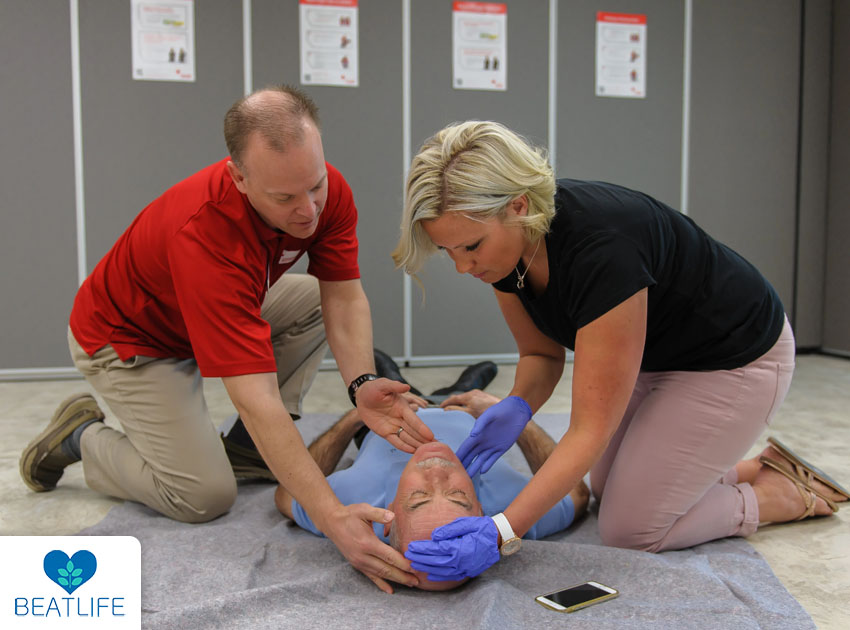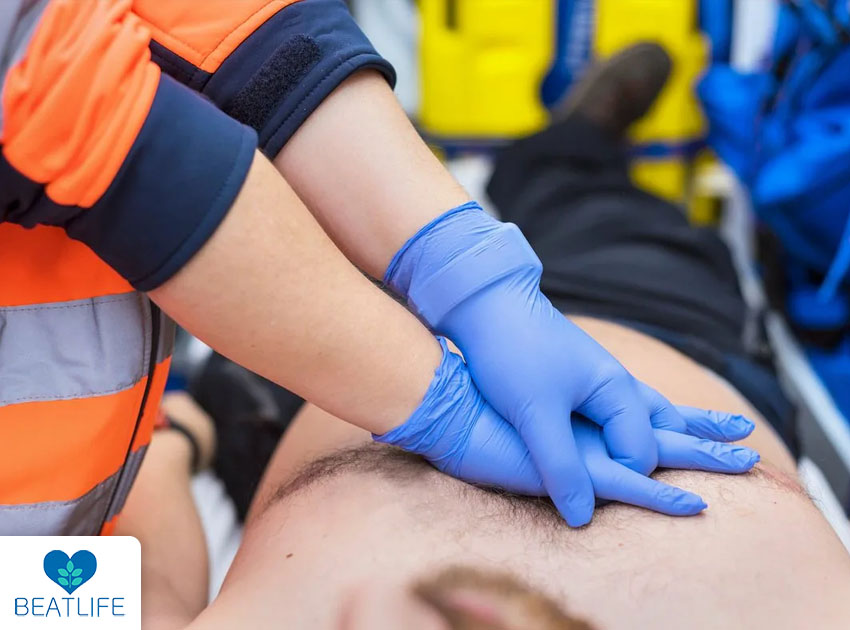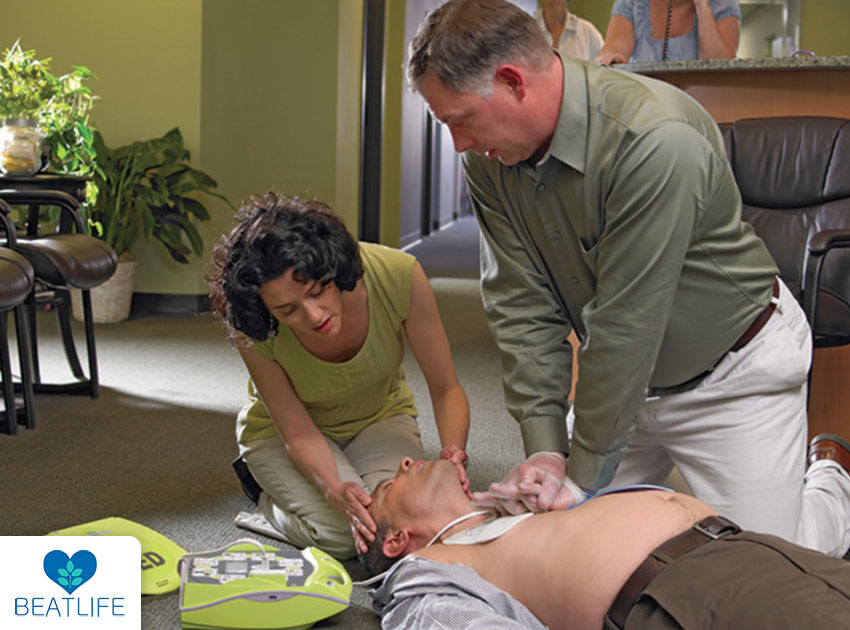CPR, or Cardiopulmonary Resuscitation, is a simple yet essential and powerful life-saving technique that plays a vital role when someone experiences cardiac arrest and can make a critical difference in a life-or-death situation. We will investigate how CPR saves lives and its remarkable impact in increasing the chance of survival. We will also explore the critical aspects of this technique and how to initiate CPR in a real-life emergency.
Cardiac arrest occurs when the heart stops beating, and its ability to pump and flow blood to the vital organs ceases abruptly; it can happen suddenly and unexpectedly to anyone. It is a silent threat, mainly due to factors such as heart attacks, electric shocks, or severe trauma. Recognizing the victims of cardiac arrest and identifying the need for CPR is crucial when the victim suddenly loses consciousness or stops breathing, as these signs indicate a cardiac arrest emergency.
However, what is cardiac arrest? How can one be of assistance in such emergencies? Does performing CPR require formal training? Moreover, what qualities do good chest compressions have to increase the chances of survival? We will address these questions, emphasizing how CPR saves lives during cardiac arrest and what doctors monitor in patients after experiencing cardiac arrest.
Contents
How CPR Saves Lives?
CPR is a technique performed in emergencies and when someone is facing cardiac arrest. During cardiac arrest, the heart ceases to beat; therefore, the blood flow is interrupted. Due to the lack of blood circulation, vital organs, including the brain, are deprived of oxygen. In such cases, CPR can help maintain blood circulation and oxygen delivery to these organs and buy some time until the first responders arrive.
CPR can bridge the gap between life and death. Performing CPR serves two crucial functions. Firstly, it helps to supply the needed oxygen to the victim’s body. By performing chest compressions, CPR manually pumps blood to vital organs during performing chest compressions to ensure they receive the oxygen necessary to survive. This prevents irreversible damage that lack of oxygen can cause to the body and organs.
Moreover, secondly, CPR helps to maintain blood circulation. When the heart stops, blood flow halts abruptly. The rhythmic compressions help stimulate the heart, coaxing it back into action. Sustaining the body’s oxygen supply and circulation by performing CPR increases the possibility of the victim’s survival. In other words, CPR saves lives.

When Does Someone Need CPR?
Cardiac arrest can happen to anyone, anywhere, at any time. Identifying the victim’s need for CPR is the priority before performing effective CPR. Cardiac arrest, which various factors can trigger, is a sudden life-threatening condition requiring immediate action. It becomes essential to initiate CPR when the victim becomes unresponsive, stops breathing, or irregularly gasps for air while effective breathing is not happening, indicating an emergency and something is seriously wrong.
What Is Cardiac Arrest?
Cardiac arrest is a lethal medical emergency when the heart suddenly stops beating or beats irregularly. This critical condition demands immediate attention and action. During cardiac arrest, due to the heart’s failure to pump blood effectively, the lack of blood flow leads to an abrupt loss of oxygen supply to vital organs such as the brain.
While cardiac arrest is often confused with a heart attack, they are distinct conditions, and the signs of cardiac arrest are unmistakable. A heart attack happens when blood flow to the heart muscle is blocked, causing chest pain and other symptoms. Cardiac arrest, on the other hand, is due to the sudden loss of heart function. The heart may quiver or fibrillate and cannot circulate blood effectively, leading to unconsciousness and death if not treated promptly.
What Signs Indicate Cardiac Arrest?
Recognizing the signs of cardiac arrest is the crucial first step for identifying when someone needs CPR and when to initiate the performance. Common signs can include:
- Unresponsiveness: The person experiencing the cardiac arrest is unconscious and does not respond to external verbal cues or physical stimulation, including voice or touch.
- Absence of normal breathing: Normal breathing ceases when the victim is affected by cardiac arrest. The person may not be breathing at all, or they might only gasp for air irregularly, which is not considered effective and normal.
- Lack of Pulse: In some cases, the pulse may not be detected in the carotid or femoral arteries. However, the absence of normal breathing is a more reliable sign in such situations.
These signs are clear indicators of cardiac arrest and suggest an immediate need for action.
Do You Need Training to Give Someone CPR?
Anyone can initiate and perform CPR, and it is possible to perform CPR without any formal training. However, it is highly recommended to receive CPR training for several vital reasons. Proper training helps individuals understand how CPR saves lives in emergencies and when someone is experiencing cardiac arrest. Training can improve the quality of CPR. It equips the individual with the knowledge and skills to provide more beneficial CPR. CPR courses cover other critical aspects of CPR, including the correct techniques for chest compressions and rescue breaths and how to use automated external defibrillators (AEDs) and CPRMETER. It teaches individuals how to assess a victim’s condition and respond effectively in real-life emergencies. Knowing what measures should be taken and how to perform CPR optimally can significantly enhance a victim’s chances of survival.

What Is a Good CPR Chest Compression and Why Is It Important?
High-quality chest compressions are the critical factor of effective CPR. With proper techniques, blood can circulate throughout the body. Organs are provided with an oxygen supply, which increases the potential for survival and ensures that CPR saves lives. The following characteristics should be considered when performing CPR chest compressions to ensure beneficial and high-quality chest compressions:
- Positioning: Place the heel of one hand on the center of the victim’s chest, with the other hand on top.
- Depth: Compressions should be at least 2 inches deep for adults.
- Rate: Aim for 100-120 compressions per minute.
- Allow full chest recoil: Allow the chest to expand between compressions fully.
- Use CPRMETER: In recent years, technology has played a pivotal role in enhancing the quality of CPR. One such advancement is the CPRMETER, a device that provides real-time feedback on the quality of chest compressions. The CPRMETER By BEATLIFE helps rescuers maintain the correct compression depth, rate, and chest recoil, ensuring that every compression is performed effectively.
The importance of these parameters cannot be overstated, as proper chest compressions play a central role in maintaining blood circulation during a cardiac arrest emergency and, more importantly, they ensure the oxygen is effectively circulated throughout the body, particularly to the brain and other vital organs and therefore minimizing and preventing the risk of the brain damage due to the lack of oxygen and increasing the likelihood of survival of the victim.
What Do Doctors Monitor After Cardiac Arrest?
In the aftermath of a cardiac arrest, medical professionals closely monitor the patient, looking for several critical factors to assess the condition and guide their care and full recovery. These key indicators offer insights into the patient’s overall health and potential for recovery:
1. Neurological Status: Doctors pay close attention to the patient’s consciousness level and neurological function. They also evaluate the responsiveness and movements, including the patient’s ability to follow commands, move limbs, and respond to stimuli. Any signs of neurological impairment are assessed carefully.
2. Cardiac Function: Continuous monitoring of the patient’s heart rhythm, electrical activity, and overall performance is essential. Doctors watch closely for any signs of arrhythmias or abnormalities, which calls for medical measures. The cardiac function must be stabilized to prevent further cardiac events
3. Oxygen Levels: Monitoring oxygen saturation levels in the blood is crucial to ensure adequate oxygen supply to the body. oxygen delivery is an essential factor for organ function and recovery. Low oxygen levels can lead to further complications, so maintaining proper oxygenation is a priority.
4. Organ Function: The functionality of vital organs such as the kidneys, liver, and lungs is closely observed. Cardiac arrest can lead to secondary organ damage, so doctors ensure these organs function properly.
Overall, medical professionals carefully examine the mentioned factors to make informed decisions about the patient’s treatment and to provide the best possible treatment for a successful recovery after a cardiac arrest. Recovering after cardiac arrest can be long and challenging, but early and effective CPR saves lives by significantly increasing the chances of a positive outcome.
Conclusion
In conclusion, CPR saves lives during cardiac arrest, and this measure cannot be underestimated regarding the victims’ well-being and the difference between life and death. Understanding when the victim needs CPR, recognizing the signs of cardiac arrest, and knowing the role of high-quality chest compressions are vital components when performing CPR. While formal training is not always obligatory proper knowledge and skills on how to administer CPR effectively, significantly increases the chances of a successful outcome.
Post-cardiac arrest, medical professionals closely monitor neurological status, cardiac function, oxygen levels, and overall organ function. These observations are essential in providing treatment to the patient and facilitating their recovery. Effective CPR improves the chances of resuscitation and lays the foundation for a successful recovery, reducing the risks associated with cardiac arrest. CPR can offer hope and a second chance in life’s direst circumstances. Therefore, the key takeaway is simple: CPR saves lives, a skill we should all strive to learn and master.

